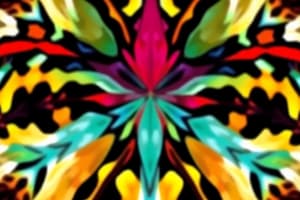Podcast
Questions and Answers
What is the difference between asymmetry and radial symmetry?
What is the difference between asymmetry and radial symmetry?
Asymmetry is the lack of equality or equivalence between parts or aspects of something; lack of symmetry. Radial symmetry is symmetry around the central axis.
Identify the symmetry of the following objects:
Identify the symmetry of the following objects:
Fork = Bilateral symmetry Jagged piece of rock = Asymmetry Rubber ball = Radial symmetry
How is bilateral symmetry distinct from radial symmetry?
How is bilateral symmetry distinct from radial symmetry?
Bilateral symmetry is the property of being divisible into symmetrical halves on either side of a unique plane. Radial symmetry is symmetry around the central axis.
List the key differences between protosomes and deuterostomes.
List the key differences between protosomes and deuterostomes.
List the animal phyla classified as protostomes and those classified as deuterostomes.
List the animal phyla classified as protostomes and those classified as deuterostomes.
What distinguishes a bivalve mollusk from a cephalopod?
What distinguishes a bivalve mollusk from a cephalopod?
What does pseudocoel mean and why is this term applied to the body cavity of roundworms?
What does pseudocoel mean and why is this term applied to the body cavity of roundworms?
List at least three differences between insects and spiders.
List at least three differences between insects and spiders.
List the four defining features of chordates.
List the four defining features of chordates.
Why are sea squirts and lancelets referred to as invertebrate chordates?
Why are sea squirts and lancelets referred to as invertebrate chordates?
What are characteristics of mammals that set them apart from other vertebrate chordates?
What are characteristics of mammals that set them apart from other vertebrate chordates?
Echinoderms and chordates are ______.
Echinoderms and chordates are ______.
Which structure is not a major diagnostic feature of the chordates?
Which structure is not a major diagnostic feature of the chordates?
Which animal is a chordate?
Which animal is a chordate?
Which of the following is a cephalopod?
Which of the following is a cephalopod?
Invertebrates ______.
Invertebrates ______.
One of the major distinguishing characteristics of mollusks is ______.
One of the major distinguishing characteristics of mollusks is ______.
What are the 3 classes of platyhelminthes?
What are the 3 classes of platyhelminthes?
Which of the 3 classes of platyhelminthes are free-living and not parasitic?
Which of the 3 classes of platyhelminthes are free-living and not parasitic?
What are the 4 classes of molluscs?
What are the 4 classes of molluscs?
What are the 3 classes of annelids?
What are the 3 classes of annelids?
What are the 4 subphylums of Arthropoda?
What are the 4 subphylums of Arthropoda?
What is the largest insect?
What is the largest insect?
What are the 5 classes of Echinodermata?
What are the 5 classes of Echinodermata?
Flashcards
Asymmetry
Asymmetry
Lack of symmetry; no equivalent parts.
Radial Symmetry
Radial Symmetry
Symmetry around a central axis.
Bilateral Symmetry
Bilateral Symmetry
Symmetrical halves on either side of a plane.
Protosome
Protosome
Signup and view all the flashcards
Deuterostome
Deuterostome
Signup and view all the flashcards
Mollusca
Mollusca
Signup and view all the flashcards
Arthropoda
Arthropoda
Signup and view all the flashcards
Annelida
Annelida
Signup and view all the flashcards
Chordata
Chordata
Signup and view all the flashcards
Echinodermata
Echinodermata
Signup and view all the flashcards
Bivalve Mollusk
Bivalve Mollusk
Signup and view all the flashcards
Cephalopod
Cephalopod
Signup and view all the flashcards
Pseudocoel
Pseudocoel
Signup and view all the flashcards
Book Lungs
Book Lungs
Signup and view all the flashcards
Antennae
Antennae
Signup and view all the flashcards
Notochord
Notochord
Signup and view all the flashcards
Vertebral Column
Vertebral Column
Signup and view all the flashcards
Invertebrate
Invertebrate
Signup and view all the flashcards
Mammals
Mammals
Signup and view all the flashcards
Mantle
Mantle
Signup and view all the flashcards
Weta
Weta
Signup and view all the flashcards
Study Notes
Symmetry in Animals
- Asymmetry: lack of symmetry, no equivalent parts; example: jagged rock.
- Radial symmetry: symmetry around a central axis; example: starfish.
- Bilateral symmetry: symmetrical halves on either side of a unique plane.
Symmetry Classification
- Fork: bilateral symmetry.
- Jagged piece of rock: asymmetry.
- Rubber ball: radial symmetry.
Protosomes vs. Deuterostomes
- Protosomes: blastopore becomes the mouth.
- Deuterostomes: blastopore becomes the anus.
Classes of Animals
- Protosomes: include phyla such as Mollusca, Arthropoda, Annelida.
- Deuterostomes: include phyla such as Chordata, Echinodermata.
Mollusk Class Distinction
- Bivalve mollusks: characterized by two hinged shells.
- Cephalopods: include octopuses and squids, known for advanced nervous systems.
Pseudocoel in Roundworms
- "Pseudocoel" refers to a body cavity that is not fully lined by mesoderm; characteristic of roundworms.
Differences Between Insects and Spiders
- Spiders possess book lungs; insects do not.
- Insects have antennae; spiders lack antennae.
- Spiders have two main body parts, while insects have three.
Chordate Characteristics
- Four defining features of chordates: notochord, dorsal hollow nerve cord, pharyngeal slits, post-anal tail.
- Sea squirts and lancelets are invertebrate chordates, lacking a backbone.
Mammals' Distinct Traits
- Unique characteristics of mammals may include hair, mammary glands, and three middle ear bones.
Echinoderms and Chordates
- Both are classified as deuterostomes; their blastopore develops into the anus.
Diagnostic Features of Chordates
- Major diagnostic feature: vertebral column is not a defining characteristic for all chordates.
Classification of Animals
- Lancelet: identified as a chordate.
- Octopus: a cephalopod.
- Invertebrates: lack a vertebral column and exclude all members of phylum Chordata.
Mollusk Characteristics
- One distinguishing characteristic of mollusks: presence of a mantle.
Classes of Platyhelminthes
- Three classes:
- Tubeliaria (flatworms): free-living.
- Trematoda (flukes): parasitic.
- Cestoda (tapeworms): parasitic.
Classes of Mollusks
- Four classes:
- Polyplacophora (chitons).
- Gastropoda (snails, slugs).
- Bivalvia (clams, mussels, oysters).
- Cephalopoda (squids, octopuses).
Classes of Annelids
- Three classes:
- Oligochaeta: segmented worms in various habitats.
- Polychaeta: mostly marine segmented worms.
- Hirudinea: leeches.
Subphyla of Arthropoda
- Four subphyla:
- Cheliceriforms: horseshoe crabs, spiders.
- Myriapoda: millipedes, centipedes.
- Hexapoda: insects, springtails.
- Crustacea: crabs, lobsters.
Largest Insect
- The Weta holds the title of the largest insect.
Classes of Echinodermata
- Five classes:
- Asteroidea: sea stars.
- Ophiuroidea: brittle stars.
- Echinoidea: sea urchins, sand dollars.
- Crinoidea: sea lilies, feather stars.
- Holothuroidea: sea cucumbers.
Studying That Suits You
Use AI to generate personalized quizzes and flashcards to suit your learning preferences.




